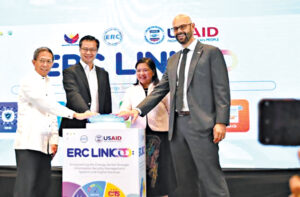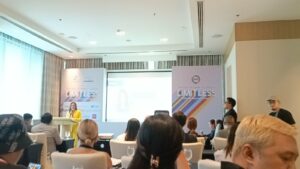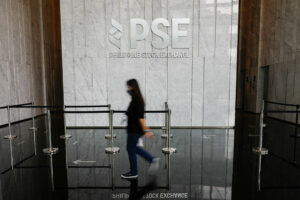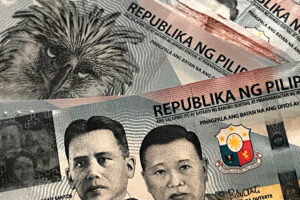Many industries face the simultaneous push for digitalization and decarbonization, and our energy sector is not spared from this. Leveraging digital technology is even found to be a significant way to enhance clean energy adoption and improve energy efficiency.
In the Philippines, the Energy Regulatory Commission (ERC) is reinventing energy regulation through digital innovation, ensuring that the Philippine energy sector meets the needs of the growing economy.
This innovation comes in the form of ERC LINKod, which seeks to make the processes of its services more efficient through the use of digital technology.
“[ERC LINKod is] a suite of consumer-centric digital programs aimed at enhancing efficiency, transparency and accessibility in ERC provision of public service fortified by an information security management system,” ERC Chairperson and Chief Executive Officer Monalisa C. Dimalanta explained in her remarks during the launch of ERC LINKod last year.
Services currently offered and accessible to the public under ERC LINKod include Billing and Revenue System — Cashiering System (BRS-CS), Consumer Complaints Ticketing System (CCTS), Online Filing and Application System (OFAS), Online Uniform Reportorial Requirements System (OURRS), and Competitive Retail Electricity Market — Monitoring and Reporting System (CREM-MRS).
BRS-CS, according to the ERC’s website, streamlines financial transactions for stakeholders by facilitating the online issuance of billing statements and revenue collection.
CCTS, meanwhile, facilitates the management and resolving of consumer electricity-related issues.
OFAS makes it convenient for stakeholders to file applications seamlessly through electronic submission of required documents.
By simplifying the submission of reportorial requirements and streamlining confirmation process, OURRS seeks to reduce regulatory lags and volume of cases filed and pending before the ERC.
Lastly, expediting monitoring and analysis of data within the competitive retail electricity market, CREM-MRS enables better insights into the retail market, including a score card for reference of contestable customers.
Also accessible under the ERC LINKod tab on the ERC’s official website (https://www.erc.gov.ph/) is the Energy Virtual One-Stop Shop (EVOSS) system. The EVOSS, its own website explains, is a Web-based filing and monitoring system for energy-related applications and a repository of information and permits issued for energy projects, which is shared by all agencies and entities involved in the approval process.
Also part of the ERC LINKod initiative is the enhanced ERC website, which now provides stakeholders with relevant and real-time information in more transparent and accessible means.
Amid a growing need for a more responsive energy landscape, handling consumer complaints remains a challenge, sometimes even hindering the progress of services. In response, ERC LINKod aims to reduce 50% of processing time for all services, ultimately enhancing efficiency and saving time for both the organization and its consumers.
“ERC LINKod is just the first set towards a future of shared success and progress in the Philippine energy sector,” Ms. Dimalanta said.
“As the ERC LINKod advances the ERC into the digital age, the electricity consumers can look forward to a more transparent and responsive energy landscape,” she added.
Secured platforms
Moreover, a significant aspect of the ERC LINKod initiative is the focus on cybersecurity, with the ERC implementing robust global security measures across its digital platforms. The digital platform is supported by the recent Information Security Management System (ISMS), ensuring a better and more secure cyberspace in the ERC platforms.
According to US Agency for International Development (USAID), the ERC has achieved ISO certification ensuring a higher level of security and strengthened security measures in all transactions, making the commission well-equipped to deploy ERC LINKod.
“ERC LINKod also aligns with the government’s priority areas of digitalization, safe cyberspace, citizen-centric governance, digital inclusion and innovation-driven economy as we confront our enormous challenges that remain and those that are yet to arise in the coming years,” ERC’s Ms. Dimalanta said during the launch.
“We hope to add more programs to ERC LINKod as we continue to pursue with all of you the energy sector’s journey towards more efficient, transparent and accessible services,” the ERC chief added.
As the ERC embarks on its own digital journey, it adopts a new regulatory paradigm that leverages digital tools and transform the Philippine energy sector that meet its energy and power needs.
“It is therefore imperative for the commission to adopt a new paradigm in regulating the power sector. One that optimizes the utilization of digital tools. Hence, this digital transformation journey begins with ERC LINKod,” Ms. Dimalanta said.
Partnering with USAID
In forming ERC LINKod, the commission has partnered with the USAID, with the goal to improve energy regulation that will drive the adoption of cleaner energy in the Philippines.
“It is great to see that as public servants, we are all moving forward in providing greater service to the people of the Philippines,” Ryder Rogers, director of the Environment Office of USAID Philippines, remarked during the launch of ERC LINKod. “This will strengthen energy governance and will ultimately advance consumer welfare and energy democracy.”
Factoring in the transformation of the energy sector to a more secured, competitive, reliable and more affordable landscape for Filipinos, the USAID will continue supporting the ERC to enhance its capacity and advance reforms in the sector.
“USAID will continue… to provide assistance to ERC to help strengthen the institutional capacity of the regulator to respond to the emerging challenges of the energy sector and the continuing implementation of the power sector reforms,” the agency was quoted as saying in a BusinessWorld report last December.
The ERC and USAID have a long-standing partnership that dates back to 2001. The USAID recognizes the Philippines as a key partner for sustainable and inclusive development. According to the USAID, it invests approximately $120 million yearly to support development programs in the country.
“The Philippines is a key partner in promoting sustainable and inclusive development in the region. USAID is among the largest bilateral donors to the Philippines and invests approximately $120 million annually to promote inclusive, market-driven growth,” it said. — Angela Kiara S. Brillantes





